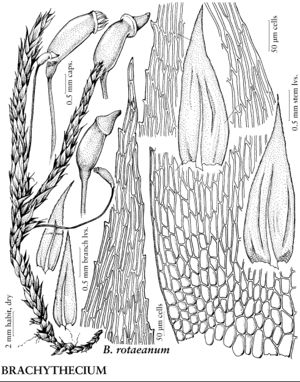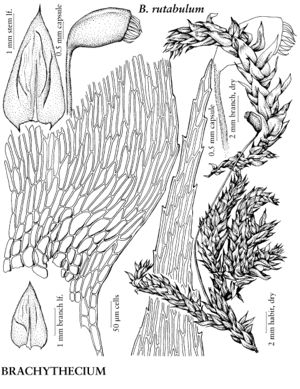Brachythecium
in P. Bruch and W. P. Schimper, Bryol. Europ. 6: 5, plates 535 – 555. 1853.
| Taxon | Illustrator ⠉ | |
|---|---|---|
 | Brachythecium cirrosum | Patricia M. Eckel |
 | Brachythecium rotaeanum | Patricia M. Eckel |
 | Brachythecium rutabulum | Patricia M. Eckel |
Plants small to large, in loose to dense mats, light to dark green, sometimes whitish, yellowish, or brownish, pale stramineous to yellowbrown with age. Stems creeping, ascending, erect, or arching, not reddish, densely to loosely terete-foliate, rarely subcomplanate-foliate or julaceous, irregularly or sometimes regularly pinnate, branches terete, subcomplanate, or complanate-foliate; central strand present; pseudoparaphyllia acute to acuminate; axillary hairs of 2–4 cells, cells long, 3–6: 1. Stem-leaves appressed, erect, spreading, patent, or falcate-secund, loosely or tightly imbricate, rarely somewhat spaced, lanceolate, ovate, or triangular, slightly to strongly concave, strongly to weakly longitudinally plicate, or plicae irregular, appearing crumpled, or not plicate; base narrowly to broadly short to long-decurrent; margins serrate, serrulate, or entire, teeth never recurved; apex abruptly or gradually tapered or acuminate, occasionally piliferous; costa to 40–80% leaf length, moderate to somewhat stout, terminal spine present or absent; alar cells usually differentiated, larger or smaller than basal-cells, walls thin when cells enlarged, region conspicuous or not, more pellucid or otherwise more opaque; laminal cells usually linear, 8–15: 1, occasionally 20: 1 or 3–5: 1, walls thin to moderately thick, rarely as thick as lumen (B. cirrosum and B. turgidum); basal-cells shorter, often wider than more distal cells, walls usually moderately incrassate, region opaque or pellucid across base. Branch leaves usually smaller and narrower; apex more gradually acute or acuminate. Sexual condition autoicous or dioicous; perichaetial leaves reflexed, apex gradually or abruptly acuminate. Seta redbrown with some variation in color in different species, darker with age, rough or smooth. Capsule inclined, horizontal, or somewhat pendent (erect in B. acuminatum), color similar to that of seta, usually darker, ovate, elongate, or cylindric, straight to curved; annulus not separating or separating by fragments; operculum conic, sometimes broadly short-rostrate; peristome xerocastique, perfect (reduced in B. acuminatum). Calyptra naked. Spores 9–25 µm.
Distribution
Nearly worldwide, high Arctic to tropics
Discussion
Species ca. 80 (21 in the flora).
Many species of Brachythecium exhibit a broad range of variation. Inadequate collections make it difficult if not impossible to separate superficially similar species. Large plants with well-developed stem leaves and fertile collections are most often necessary for the correct identification of Brachythecium. The following key ignores many marginal morphotypes of widespread species, although some of these are discussed in detail in the comments. The present circumscription of Brachythecium is narrower than in previous floras as some species have been placed in Sciuro-hypnum (species related to S. glaciale, S. populeum, S. reflexum, and S. starkei) and Brachytheciastrum (species related to B. collinum and B. velutinum), following M. S. Ignatov and S. Huttunen (2002).
Selected References
None.
Lower Taxa
Key
| 1 | Alar cells enlarged; often wet to mesic habitats | > 2 |
| 1 | Alar cells same size or smaller than adjacent basal cells, rarely slightly enlarged; mesic to xeric habitats | > 8 |
| 2 | Sexual condition autoicous | > 3 |
| 2 | Sexual condition dioicous | > 5 |
| 3 | Setae rough; leaf margins serrulate to serrate; mesic habitats, deciduous forests of e North America. | Brachythecium rutabulum |
| 3 | Setae smooth; leaf margins subentire or evenly serrulate; arctic and wetland species | > 4 |
| 4 | Stem leaves ovate; apices abruptly acuminate; margins serrulate; Alaska. | Brachythecium boreale |
| 4 | Stem leaves ovate-triangular; apices gradually tapered or gradually acuminate; margins minutely serrulate to subentire; widespread in wet habitats. | Brachythecium acutum |
| 5 | Leaf margins entire to slightly serrulate; setae unknown; Alaska. | Brachythecium udum |
| 5 | Leaf margins serrulate to serrate, rarely subentire; setae rough; widespread | > 6 |
| 6 | Leaves narrow, stem leaves 2-3:1; branch leaves 3-4:1. | Brachythecium asperrimum |
| 6 | Leaves broad, stem leaves 1.5-2.5(-3):1; branch leaves 2-3:1 | > 7 |
| 7 | Alar regions not large, not saclike, enlarged cells separated from margin. | Brachythecium frigidum |
| 7 | Alar regions large, somewhat saclike, enlarged cells extending almost to margins. | Brachythecium rivulare |
| 8 | Leaf apices abruptly contracted, acumina filiform | > 9 |
| 8 | Leaf apices gradually tapered, often long-acuminate | > 11 |
| 9 | Sexual condition autoicous; basal laminal cell walls thick. | Brachythecium turgidum |
| 9 | Sexual condition dioicous; basal laminal cell walls weakly to moderately thick | > 10 |
| 10 | Alar regions opaque or moderately pellucid, cells subquadrate; laminal cells 30-80(-100) × 6-7 µm. | Brachythecium cirrosum |
| 10 | Alar regions ± pellucid, cells short-rectangular; laminal cells 40-80 × 8-12 µm. | Brachythecium brandegeei |
| 11 | Plants small; stem leaves 0.6-1.4 × 0.4-0.6 mm; basal and alar cells almost undifferentiated; setae rough; California, Oregon. | Brachythecium bolanderi |
| 11 | Plants and leaves usually medium-sized to large, if smaller then basal or alar cells distinctly differentiated; setae smooth (rough in B. campestre); widespread | > 12 |
| 12 | Leaf margins serrulate to serrate, occasionally nearly entire | > 13 |
| 12 | Leaf margins entire, subentire, or with very small teeth that do not enlarge in acumen | > 18 |
| 13 | Alar regions not clearly differentiated; basal laminal cells in 3-8 rows, markedly different from more distal cells | > 14 |
| 13 | Alar regions ± clearly delimited; basal laminal cells in 1-3 rows, not markedly different from more distal cells | > 16 |
| 14 | Stem leaves deeply plicate; basal laminal cells (6-)8-11 µm wide, regions opaque. | Brachythecium laetum |
| 14 | Stem leaves not to moderately plicate; basal laminal cells 11-16(-19)µm wide, regions usually pellucid | > 15 |
| 15 | Plants small; stem leaves 1-1.6 × 0.3-0.6 mm. | Brachythecium acuminatum |
| 15 | Plants medium-sized to moderately large; stem leaves (1.7-)2-2.8 × 0.6-0.9 mm. | Brachythecium rotaeanum |
| 16 | Leaves broadly ovate; apices gradually to abruptly long-acuminate; leaves 1.1-1.5(-1.9) × 0.5-0.7(-0.8) mm; sw United States. | Brachythecium ruderale |
| 16 | Leaves ovate-triangular or ovate-lanceolate; apices gradually tapered or acuminate; leaves 1.5-2.6 × 0.5-1.2 mm; widespread | > 17 |
| 17 | Setae rough or occasionally smooth; leaves broadest at 1/9-1/7 leaf length. | Brachythecium campestre |
| 17 | Setae smooth; leaves broadest at 1/10-1/7 leaf length. | Brachythecium salebrosum |
| 18 | Alar regions small or poorly delimited; sexual condition dioicous or autoicous | > 19 |
| 18 | Alar regions extensive; sexual condition dioicous | > 23 |
| 19 | Plants large, rigid; leaves strongly plicate; laminal cell walls thick, especially at base where strongly porose; arctic, alpine. | Brachythecium turgidum |
| 19 | Plants small to large, if large then not rigid; leaves not to somewhat plicate; laminal cell walls moderately thick to moderately thin, not or moderately porose; widespread | > 20 |
| 20 | Sexual condition autoicous | > 21 |
| 20 | Sexual condition apparently dioicous (male plants and sporophytes unknown) | > 22 |
| 21 | Leaves broadly to narrowly ovate-triangular, 0.8-1.2 mm wide; widespread. | Brachythecium acutum |
| 21 | Leaves ovate-lanceolate or lanceolate, 0.6-0.8 mm wide; Alaska. | Brachythecium jacuticum |
| 22 | Alar cells relatively small; alpine belt in Rocky Mountains. | Brachythecium brandegeei |
| 22 | Alar cells enlarged; Alaska. | Brachythecium udum |
| 23 | Leaves 1.1-1.5(-1.9) × 0.5-0.7(-0.8) mm, broadly ovate; acumina often as long as base; sw United States. | Brachythecium ruderale |
| 23 | Leaves (1.2-)1.5-2.8 × (0.4-)0.6-1.1 mm, ovate-lanceolate to ovate; acumina markedly shorter than base; widespread | > 24 |
| 24 | Leaves straight to falcate-secund, strongly plicate. | Brachythecium erythrorrhizon |
| 24 | Leaves straight or slightly falcate, if falcate, not or moderately plicate | > 25 |
| 25 | Leaf apices long-acuminate; bases long-decurrent; laminal cells 40-100 (-125) × 5-9 µm. | Brachythecium albicans |
| 25 | Leaf apices short to moderately acuminate; bases short-decurrent; laminal cells 30-80(-90) × 6-9 µm | > 26 |
| 26 | Leaf decurrency cells short-rectangular. | Brachythecium coruscum |
| 26 | Leaf decurrency cells long-rectangular. | Brachythecium erythrorrhizon |
"long" is not a number."broad" is not a number.